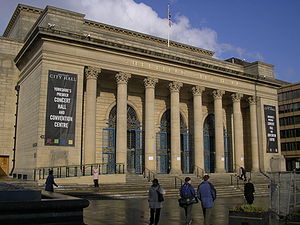| Revision as of 09:35, 1 April 2007 editCaptain scarlet (talk | contribs)Extended confirmed users6,979 editsm →External links: Rm Wikimapia spamlink, use generic← Previous edit | Revision as of 19:38, 1 April 2007 edit undoPafcool2 (talk | contribs)Autopatrolled, Extended confirmed users8,525 editsNo edit summaryNext edit → | ||
| Line 1: | Line 1: | ||
| ] | ] | ||
| '''Sheffield City Hall''' is a Grade II* ]<ref>] (1973) '']'' (accessed ] ]).</ref> containing several ]s, ranging from ] to a ], in ], ]. | '''Sheffield City Hall''' is a Grade II* ]<ref>] (1973) '']'' (accessed ] ]).</ref> containing several ]s, ranging from ] to a ], in ], ]. | ||
Revision as of 19:38, 1 April 2007

Sheffield City Hall is a Grade II* listed building containing several venues, ranging from auditoria to a ballroom, in Sheffield, England.
The large hall dominates Barker's Pool, one of the most-used squares in Sheffield, containing the city's War Memorial.
The City Hall was designed in 1920 by E. Vincent Harris, but was not completed until 1934. It is a neo-classical building with a giant portico. The largest hall in the building, seating 2,271 people, is commanded by a grand angel's chorus. This provides both natural light to the main hall and can also be used by a hidden choir whose voices are carried through the building and down onto the audience.
The City Hall and its surroundings have recently (2005) been refurbished and re-developed at a cost of £12.5million.
Now managed under a 99 year lease by the Sheffield City Trust
References
- English Heritage (1973) City Hall. Images of England (accessed 20 February 2006).